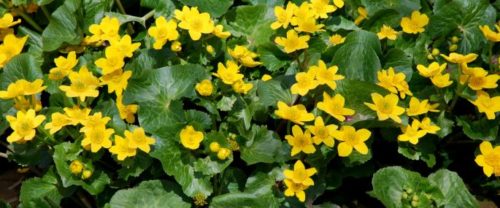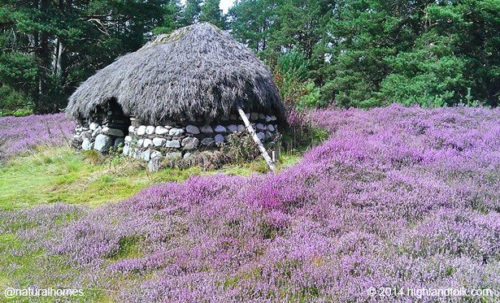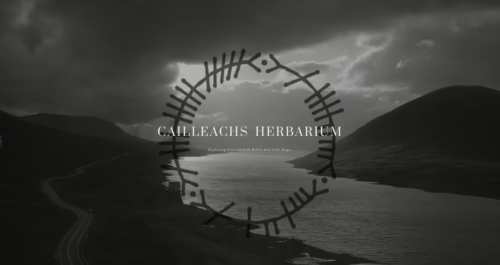Là Bealltainn, the summer hinge the swinging open of the door to Samhradh, summer. The liminal time, the otherworld now just a heart beat away. Yet in true Scottish irony it comes in with the “Gab of May“. These first days of “Summer” , the “Gab”, are traditionally cold and wet.
There are four major festivals for us. With a nod towards the Winter and summer solstice providing the structure of our year. Imbolc, La Fheil Bride, is the Mid winter festival and Lughnassadh or Lunastal the mid summer festival. Leaving Là Bealltainn the celebration of the end of winter. Samhuinn the commiseration of the end of summer (Sam huinn – summers end). Bealltainn (perhaps meaning lucky fire) is also the name reserved for this Gaelic (not neccesarily Celtic) festival. Other areas have similar festivals but they have their own names and lore. For instance in Wales, Bealltainn is Calan Mai or Calan Haf, in Germany its Walpurgis nacht. If you’re not in Scotland, it might be a great way of connecting to your own folk-lore by exploring traditions in your own area. In other areas, Là Bealltainn, christianised to rood day or roodmas, would occur on the 3rd of May. This gave rise to two Bealltainns. Where the church held sway, festivities would happen on the 3rd. Where they did not it would happen on the 1st. The saying “that you will have skill of man and beast, ye was born between the beltans“.
As with all the festivals you can choose to celebrate them however you see fit. in terms of tradition its really all over the place. Depending on which calander you use for instance it could be on or around the 13th of May or the 1st, it could be when the moon is full or new around this time or when you see the signs of nature that alert you to Bealtainns arrival. For us this signs include the flowering of the May Tree or whitethorn and when the Blackthorn has gone into leaf amongst other more personal signs.
Samhuinn and Bealltainn for me are similar in purpose Both are the two great hinges of the year. Samhuinn, however, tinged with grief, worry and sorrow. It’s about protection from the ill luck of winter months. A time to look after our own and turn our attention inward.
Divinations, offerings and appropriations and other activities carried out at both. Là Bealltainn, is about inviting in new luck. Celebrating the start of the move to the Summer sheilings, appropriating for good luck and a prosperous summer. Samhuinn is about preparing for the worse in winter. Similar activities happen at these dates but for different reasons. It’s important for us to remember these reasons, for one is hopeful the other more thoughtful.
Seasons change (people dont?)
Both these times of year are characterised by the change in season. Some say the seasons change as the sidhe/aos sith move home and they also hold great parties. At these two great times of the year people believed it was best to avoid being out and about these nights least you get caught up in the “flitting”. Personally, The sith/sidhe have always represented to me the otherworld. The otherworld to me is made up of the ancestors and the spirits of the land, They are in places one and the same, the dead can speak as the voice of barrow, lake or hill. However, the sith, our more portable brethren and other spirits, shift home or flit. Meaning a change in weather and fortune accompanies this time. This is like the idea of Flitting day on the 25th of May or Whitsuntide. Most people in Scotland only leased their houses for a year. They were able to shift their abode every twelve month. So you could stay known as “sit” or go known as a “flit”. We still have this term in use. If we do a midnight “flit” it means your leaving your flat without paying the rent or leaving a one night stand behind.
These processions were also done by the young of the community to “bring in the May”. It is truly a time of celebration. We have records of Bealltainn celebrations held all over Scotland in the records. Some of these records also point to them getting banned. We have festivals, merry-making, visiting wells and shrines for good luck and fruitfulness in the coming months. However, unlike the romantic notion of Neo-pagan idea of May handfastings and such, there are sayings that go against this. Such as “to wed in May is to wed poverty”. Or “of marriages in May, Barins die in decay”, or “Married in May and kirked in green, both Bride and Bridegroom wont long be seen.”
Reversal of normal order – Sex and the night.
We have all sorts different customs associated with this day. Some point to a reversal of the norm at this time. An example of this is the “sleepy market” held through May at Kennethmont. All its transactions were carried out during the night. It’s suggested that these transactions were “attended probably by merriment unpleasing to the civic authorities”. They tried to move it to the day time but the folks decided not to break with tradition and just stopped holding it. In Perth, we have those attending the “Dragon Hole” celebrations with dancing and piping and the accompanying “suspicion of filthiness”. The kirk also prevented this. We have the people entering woods all over Scotland, such as the Spynnie wood in Elgin and “partying” after dark. Why after dark is curious and for me points to a time of reversal and liminality.
It’s as though this was a time for folk to have a good drunk time. With dancing singing, music and sex. I do think however, this is no different to other festival days where large crowds gathered. It is mentioned at Lughnassadh, where folk are “coupled for a day“. What’s going on here is no different to what we have now at the weekends. For this reason I find the connection with Mayday, sex and the phallic maypole somewhat of a loose connection. There was no sanctioned special sex time in the pagan wheel. These kind of activities happen at all festivals as they do in life. This time would have been no different. The maypole to me, is more than likely representative of the Bile tree. Or sacred tree but that’s another blog post all together.
Civil and Kirk authorities, to keep up some order over the Bealltainn proceedings, eventually appointed people and set up rites. These were aimed at leading the merrymaking into sanitised Chiristian piety and safety. We find characters such as the Abbot of Unrule, Robin Hood, Little John, Bon Accord, Narent (latinised to Narentia meaning “of no rent or benefice”), The Abbot of Unreason, My Lord of Rason, Prior of Bon accord, etc. introduced. These could be viewed as an attempt of old school health and safety perhaps but also to remove the folk-lore and community meanings the Bealltainn has. But again it points to the chaotic inverse nature to the “natural” order that typifies these quarter days, Samhuinn is very similar. They are both very liminal times as the aos sith roam forth and the otherworld is just a blink away. The day and night where other characters were allowed to rule is the norm at these festivals. Where social order was somewhat lessened.
The De’ils Bird
Bealltainn bird lore is important (compare with the idea of the cuckoo). Bealltainn has its accompanying bird known as the devils bird, the yellow-hammer or yowling (emberiza citronella). It’s said that this bird drinks three drops of the devils blood each May morning – some say every Monday morning. In may then it used to receive less mercy than any other bird and was hunted and hung by the neck when found. The rhyme that went along with this was (swains, 1886):
Half a paddock, half a toad,
Half a yellow yowling,
Drink a drap o’ the de’ils bluid
Every May morning.
It’s said that the bird used the drop of the devils blood to paint its eggs. The colour of this bird is significant as is the company it keeps in this rhyme. A paddock for those interested is a frog. So here we have two liminal animals connected with a third the yellow hammer. Its interesting to note that both frogs and toads were traditionally considered witch familiars but also cross both land and water. The Yellow hammer as its names suggests is all yellow and other flora and fauna associated with this festival are the same colour. For instance, the Lus buidhe Bealltainn, the Bealltainn plant, is the Marsh Marigold in Scots Gaelic and its bright yellow. The yellow or Golden Bealltainn was also an important name given to this festival. So, I think the killing of this bird (mostly in the highlands, where this bird can no longer be found) was an attempt by the Kirk to promote superstition around this holiday festival. I can’t be sure of this and for what purpose, I don’t know but perhaps this little bird had more relationship to this holiday than we realise.
Fires- Protection, offerings and charms
To prevent livestock, homes and other items that we held dear being inflicted with bad luck or caught up in the movement of the aos sith different activities are undertaken. It wasn’t uncommon for folks to drive their cattle and children between through the two Bealltainn fires removing any ill wish from over the winter. These fires are kindled in a very special way from a need fire or a tein-egin. Those who created this need fire would carry no iron and they were started from friction. A lesser know custom was to stop a criminal between the two fires and gave rise to the saying “he is betwixt two Beltein fires”. I.e he is in extreme danger. (MacBain, 1917)
In other places in Scotland Woodbine and Rowan hoops were crafted and young people and live stock were passed through them. Similar to the tradition that would happen in the March full moon. Other would tie small rowan crosses to the tails of cattle with scarlet red thread. Others would leave sprigs of Juniper, woodbine or notched Rowan on their sills and openings. Other charms involved the covering of the face in dew for beauty and divination by snail to divine the name of a future spouse. Drinking of the first water in wells was also undertaken and wells and shrines visited. Folks also held watch overnight to witness the raising of the sun. Everyone brought in yellow flowers and foliage too. For more on this please visit Tairis where they have a wealth of great Celtic Reconstructionist information especially around these different activities.
The Cailleach at Bealltainn
The person who officiated over the Beallteinn fires produced a large bannock or am bonnach beal-teine. This was then broken into pieces and one of them coloured black with soot. This black piece was termed the Cailelach beal-teine, the Old lady of Bealtainn or the Bealtainn carlin (ogre). Whoever drew this by lot was thus named. The company around them would try to throw them into the fire only to be rescued last minute. They would also be pelted with eggshells and keep this name throughout the year. (Banks, 1936). This is echoed by John Horne (1905). Folk would draw lots from a bonnet blindfolded of the same blackened Bannoch. If they received the darkened piece they would have to leap over the fire 3 or seven times.
What this may represent is perhaps a gift to the Cailleach, as an animistic representation of the land. The person who drew the lot a “sacrifice” of sorts to her. Who knows. But you can include offerings to the Cailleach in your own practice at this time of year in a similar way. Other evidence of sacrifice can be found in the killing of a spotless male lamb at the start of the migration, to the summer Shieling’s (Carmichael). A Rann that accompanied the later feast from the killed lamb was the rune:
‘Ann an coir gach fireach
Piseach crodh na h-airidh.’
Beside each knoll
The progeny of the sheiling cows.
What this Rann refers too I’m not sure. It seems to be asking for a lot of calves to be born over the summer and to offer them protection. To their fertility and them.
Summer Migration
Bealltainn, represents the time of summer migration. It was now the crofter’s migrate to their summer sheilings from their winter homesteads. In witchcraft and second sight (p270) John Campbell states whatever the weather this migration would take place. The cattle were driven in what is called a triall, or procession, to the summer bothies, known as Shielings, with a switch of Rowan. Anyone who saw the triall would offer it a blessing. Each Hird, or cattle handler, was gifted a switch of Rowan to handle the cattle till they returned around Samhuinn, when the crop fully ripened and all hands were needed.
The Song/hymn called the Traill found in the Carmina Gadelica is below. Folks would invoke their own gods. Protestants prevailed in Lewis where they would involve the Trinity. Catholicism prevailed in Uist (where I think the Triall is taken from). Where they would invoke St Micheal of the three-cornered shield and flaming sword patron of their horses. St Columba of the holy deed and guardian of the cattle. Bride of the clustering hair shepherdess of the white flock.
You can see how this can easily be adapted for what ever use you may have. When you know the corresponding ideas associated. Please do this if the format offered doesn’t suit your needs.
Laoidh an Triall. (Hymn of the procession)
VALIANT Michael of the white steeds,
Who subdued the Dragon of blood,
For love of God, for pains of Mary’s Son,
Spread thy wing over us, shield us all,
Spread thy wing over us, shield us all.
Mary beloved! Mother of the White Lamb,
Shield, oh shield us, pure Virgin of nobleness,
And Bride the beauteous, shepherdess of the flocks.
Safeguard thou our cattle, surround us together,
Safeguard thou our cattle, surround us together.
And Columba, beneficent, benign,
In name of Father, and of Son, and of Spirit Holy,
Through the Three-in-One, through the Trinity,
Encompass thou ourselves, shield our procession,
Encompass thou ourselves, shield our procession.
O Father! O Son! O Spirit Holy!
Be the Triune with us day and night,
On the machair plain or on the mountain ridge
Be the Triune with us and His arm around our head,
Be the Triune with us and His arm around our head.
BARRA FISHERMEN–
O Father! O Son! O Spirit Holy!
Be thou, Three-One, with us day and night,
And on the back of the wave as on the mountain side
Our Mother shall be with us with her arm under our head.
And on the back of the wave as on the mountain side
Our Mother shall be with us with her arm under our head.
Conclusion
There are lots of Bealltainn customs I havent written about here and if you’d like to know more the Tairis website is great for well researched historical material.
I hope that this post gives you some idea and pauses for thought about the meaning behind some of our traditions. I also hope it encourages you to look a little beyond the veneer of the Bealltainn “sex sells” representation. This holiday has a deeper meaning to a community than first glance would have you understand.
i also hope its gievn you some ideas about your own celebration at this time of year and what you might like to include, such as cooking and offering lamb to friends and as offerings to the land and spirits, perhaps even the cailleach. The dressing of homes with yellow flowers and rowan wood crosses. Watching the sun rise, Bealltainn fires and the first water and dew, perhaps even divining things using snails or the frith.
I would also recommend, if you ever get the chance, to come to Edinburgh to do so when the Beltane festival is happening. Its amazing!!Whatever you do i hope you have a great time.
Slainte Mhath
References :
Alexander Carmichael (1900) Carmina Gadelica. Vol 1.
Banks (1939) British Calander Customs.
Horne (1905) Caithness.
MacBain (1917) Celtic Mythology and Religion
Swainson, (1886) Of British Birds.







1 comment
Amazing. Thank you for clarifying so many things for me, which have been coming up but had no context.